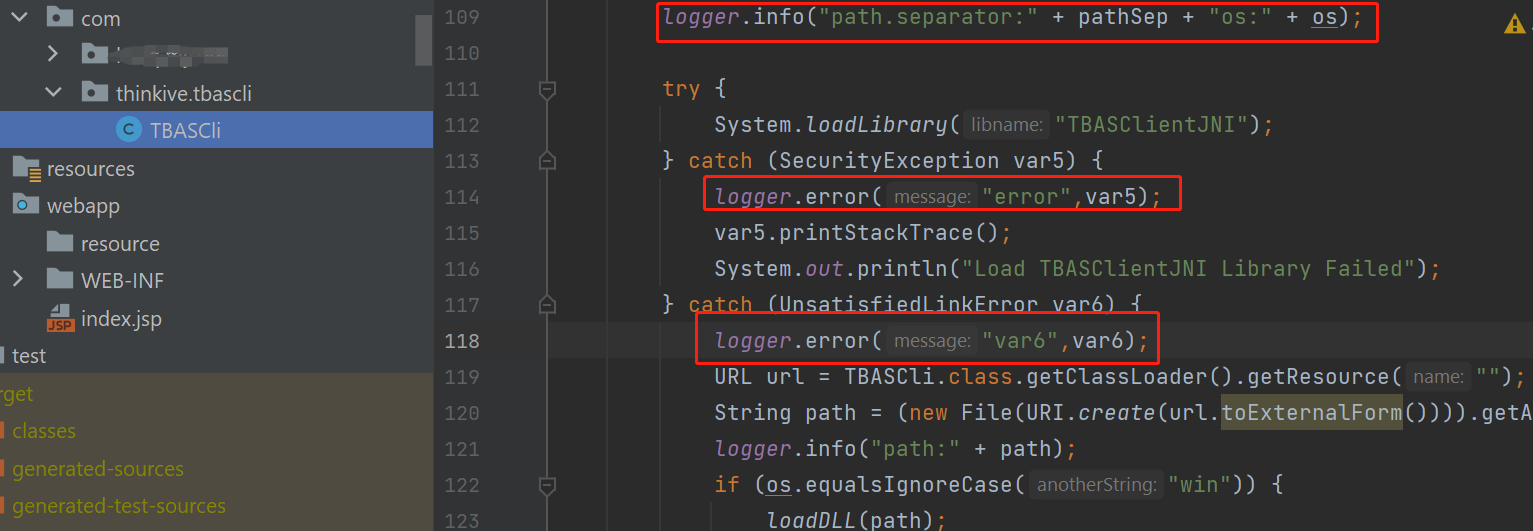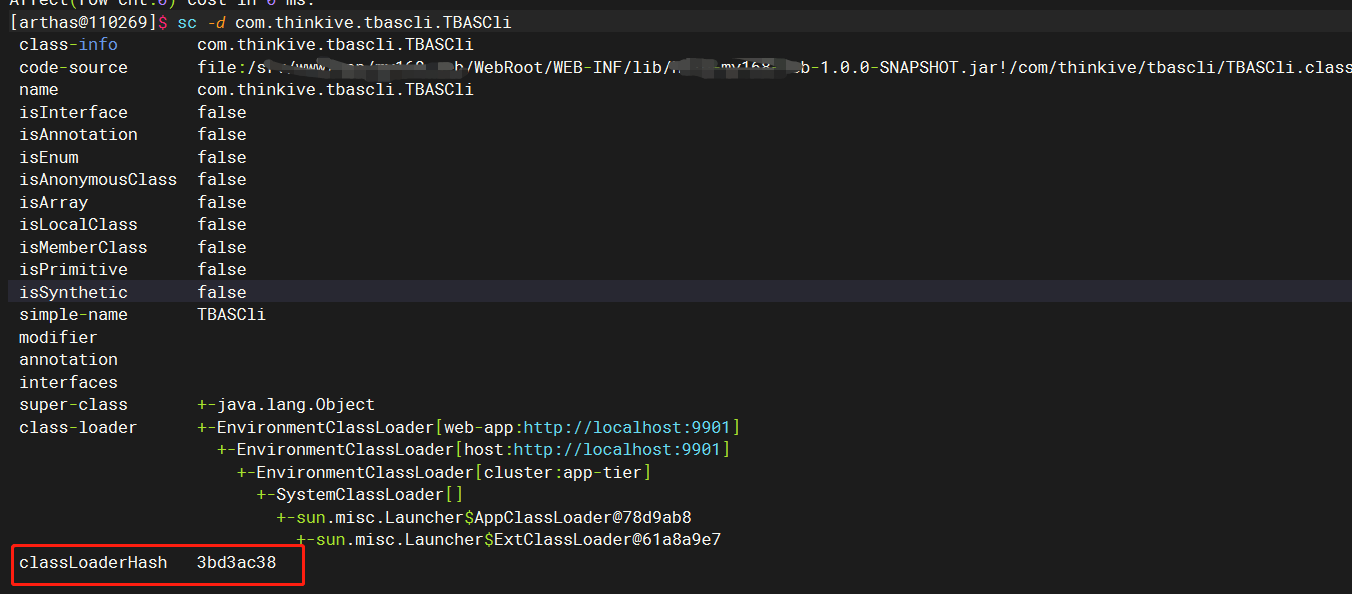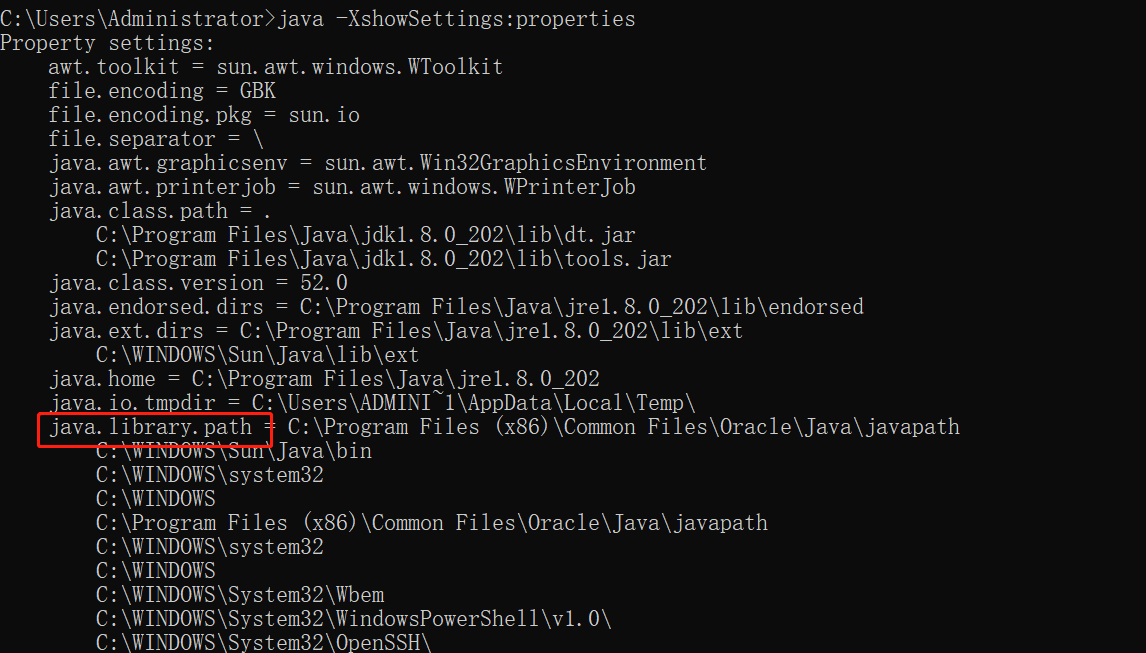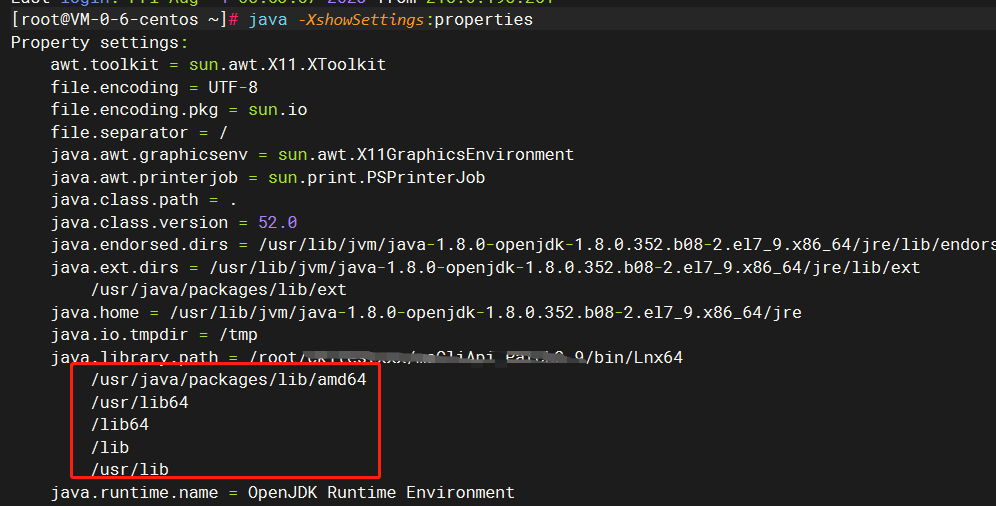本周协助测试同事对一套测试环境进行扩容,我们扩容很原始,就是新申请一台机器,直接把jdk、resin容器(一款servlet容器)、容器中web应用所在的目录,全拷贝到新机器上,servlet容器和其中的应用启动没问题。以为ok了,等到测试时,web应用报错,初始化某个类出错。报错的类长下面这样:
com.thinkive.tbascli.TBASCli
static {
String os = "win";
String pathSep = System.getProperty("path.separator");
if (pathSep.equalsIgnoreCase(":")) {
os = "linux";
}
try {
// 1
System.loadLibrary("TBASClientJNI");
} catch (SecurityException var5) {
var5.printStackTrace();
System.out.println("Load TBASClientJNI Library Failed");
} catch (UnsatisfiedLinkError var6) {
URL url = TBASCli.class.getClassLoader().getResource("");
String path = (new File(URI.create(url.toExternalForm()))).getAbsolutePath();
if (os.equalsIgnoreCase("win")) {
// 2
loadDLL(path);
} else if (os.equalsIgnoreCase("linux")) {
// 3
loadSO(path);
} else {
loadDLL(path);
}
}
...
}
复制简单来说,就是处理请求的代码用到这个类,然后类加载,执行static,结果执行System.loadLibrary失败了。
失败了也没啥,问题是,这个类是个底层框架里的类,然后失败原因也不打日志。
当时已经心里骂过人了,现在就不说啥了,说说当时处理过程。
当时以为是System.loadLibrary("TBASClientJNI");失败,抛了异常,进了catch分支,以为会进
loadDLL(path); loadSO(path);复制
private static void loadSO(String path) throws SecurityException, UnsatisfiedLinkError {
String sep = System.getProperty("file.separator");
System.load(path + sep + "libTBASClient.so");
System.load(path + sep + "libTBASClientJNI.so");
}
复制这里看到最终会调System.load方法,就想用arthas的watch观察下参数:类似于下面这样:
watch java.lang.System load '{params, target, returnObj, throwExp}' -x 2复制
结果工具报错:
[arthas@110269]$ watch java.lang.System load
Affect(class count: 0 , method count: 0) cost in 31 ms, listenerId: 1
No class or method is affected, try:
1. Execute `sm CLASS_NAME METHOD_NAME` to make sure the method you are tracing actually exists (it might be in your parent class).
2. Execute `options unsafe true`, if you want to enhance the classes under the `java.*` package.
3. Execute `reset CLASS_NAME` and try again, your method body might be too large.
复制按照工具的第二条提示,设置了,也还是报错,反正,当时这条路是没有走下去。
当时也试了去watch当前类的loadSO方法,不知道为啥,也是没观察到东西,我们用的jdk1.7,不清楚有没有影响。
上面报错这个类,在我们的TBASClientJNI-2.2.0.jar中,我想着还是覆盖框架类,加点日志试试吧,于是在应用中,新增了一个包名类名都一致的类:com.thinkive.tbascli.TBASCli,修改了其中的代码:

我们的应用,打出来的jar是在test-web.jar中,最终部署的时候,应用jar和依赖的框架jar是在同一个文件夹下,在同一个文件夹下的话,类加载的顺序是没法保证的,所以,我当时在开发环境验证了下,发现日志能看到,结果等我把改后的jar放到测试环境时,发现完全没生效,看不到日志,应该就是优先加载了旧的class。
当时也看了下,类加载的一个情况,利用arthas查看类来自哪个jar的哪个文件(以下截图来自开发环境,当时没截图):

这里也扩展下,其他类加载相关的命令:
查看类加载器及hash
classloader -l

查看类加载器的加载路径
classloader -c 3bd3ac38

然后暂时也没啥好办法,看看是不是两边是不是漏复制了啥,或者不小心改到什么地方了。把两边的几个文件夹仔细对比了下,没发现啥问题。
也对比了一些环境变量,比如linux默认会
后面在两台机器上各种排查,命令一顿敲,后面发现,在原机器上执行lsof -p pid,查看进程打开的so文件时,发现两边不太一样。
这里还要补充解释下,前面大家以为我们只是一个so文件,其实是两个,如下,其中一个是xxxJNI.so,我们代码里也是去加载这个,而不带JNI的这个so,是xxxJNI.so的内部依赖的so。
[root@xxx-access ~]# ll /test-web/WebRoot/WEB-INF/classes |grep TBA -rw-r--r-- 1 root root 20704 Feb 20 13:19 libTBASClientJNI.so -rw-r--r-- 1 root root 103904 Feb 20 13:19 libTBASClient.so复制
所以,实际上来说,我们的jdk必须加载了这两个so,请求才能正常处理。
我在原机器上执行lsof的结果是:
[root@server172 ~]# lsof -p 28644|grep TBA java 28644 root mem REG 253,1 103904 101004125 /usr/lib64/libTBASClient.so java 28644 root mem REG 253,0 20704 21663079 /test-web/WebRoot/WEB-INF/classes/libTBASClientJNI.so复制
而在新机器执行的结果是:
[root@xxx-access ~]# lsof -p 110269|grep \\.so |grep TBA java 110269 root mem REG 253,0 20704 34821647 /test_web/WebRoot/WEB-INF/classes/libTBASClientJNI.so复制
可以发现,原来的机器虽然正常运行,但是,加载的so竟然在不同文件夹下,带JNI的这个libTBASClientJNI.so,确实用的是项目路径下的;而那个libTBASClient.so,居然是/usr/lib64下的,我们确实没拷贝/usr/lib64下的那个so到新机器,估计就是这个原因了。
新机器上呢,只加载了一个so,少了一个so,估计这也就是问题原因了。
我在新机器上,试了两种改法,都有效果:
在/usr/lib64下放上那个libTBASClient.so
修改/etc/profile,设置:
export LD_LIBRARY_PATH=/test-web/WEB-INF/classes/:$LD_LIBRARY_PATH复制
为啥改了有效果呢,下面看看原理。
回到报错的那行代码:
System.loadLibrary("TBASClientJNI");复制
了解它的最好的办法,还是在本地debug。
java.lang.System#loadLibrary
public static void loadLibrary(String libname) {
Runtime.getRuntime().loadLibrary0(Reflection.getCallerClass(), libname);
}
复制java.lang.Runtime#loadLibrary0
synchronized void loadLibrary0(Class fromClass, String libname) {
ClassLoader.loadLibrary(fromClass, libname, false);
}
复制内部实现如下:
static void loadLibrary(Class fromClass, String name,
boolean isAbsolute) {
// 1 获取classloader
ClassLoader loader =
(fromClass == null) ? null : fromClass.getClassLoader();
// 2 用系统property的值来初始化field:usr_paths/sys_paths
if (sys_paths == null) {
usr_paths = initializePath("java.library.path");
sys_paths = initializePath("sun.boot.library.path");
}
// 3 外部传参为false,进不去本分支,不管
if (isAbsolute) {
if (loadLibrary0(fromClass, new File(name))) {
return;
}
throw new UnsatisfiedLinkError("Can't load library: " + name);
}
if (loader != null) {
// 4 由调用本方法的类的classloader来负责查找library,由具体classloader覆写
String libfilename = loader.findLibrary(name);
if (libfilename != null) {
File libfile = new File(libfilename);
if (!libfile.isAbsolute()) {
throw new UnsatisfiedLinkError(
"ClassLoader.findLibrary failed to return an absolute path: " + libfilename);
}
if (loadLibrary0(fromClass, libfile)) {
return;
}
throw new UnsatisfiedLinkError("Can't load " + libfilename);
}
}
// 5 根据上文初始化处,这里即是从sun.boot.library.path 这个变量中加载
for (int i = 0 ; i < sys_paths.length ; i++) {
File libfile = new File(sys_paths[i], System.mapLibraryName(name));
if (loadLibrary0(fromClass, libfile)) {
return;
}
}
// 6 根据上文初始化处,这里即是从java.library.path 这个变量中加载
if (loader != null) {
for (int i = 0 ; i < usr_paths.length ; i++) {
File libfile = new File(usr_paths[i],
System.mapLibraryName(name));
if (loadLibrary0(fromClass, libfile)) {
return;
}
}
}
// Oops, it failed
throw new UnsatisfiedLinkError("no " + name + " in java.library.path");
}
复制可以看到上面注释,加载也就是从3个地方加载;
4处,首先从classloader加载
[arthas@110269]$ classloader -c 3bd3ac38
file:/test-web/WebRoot/WEB-INF/classes/
...
复制5处,从sun.boot.library.path加载
[arthas@110269]$ sysprop sun.boot.library.path
KEY VALUE
sun.boot.library.path /usr/local/java/jdk1.7.0_80/jre/lib/amd64
复制6处,从java.library.path加载
sysprop java.library.path

所以,我们就能解释如下的结果了:
[root@xxx-access ~]# lsof -p 110269|grep \\.so |grep TBA java 110269 root mem REG 253,0 20704 34821647 /test_web/WebRoot/WEB-INF/classes/libTBASClientJNI.so复制
应该就是走了4处的逻辑,才加载到这个JNI的so。
那么,为啥又没加载到libTBASClient.so呢,我在网上看到的解释是,so内部加载其他依赖的so,这时候,内部已经不是java代码了,不可能走这段java.lang.ClassLoader#loadLibrary逻辑,所以,此时,就不是这段逻辑了。
那么,对于libTBASClientJNI.so依赖的so,又是去哪里加载呢,这块呢,我的理解不是很深入,我的理解是,在windos机器,会去PATH环境变量中加载;在linux,会去环境变量LD_LIBRARY_PATH中指定的路径加载。
但根据我这边的现象看,比如最终是在/usr/lib64中找到了libTBASClientJNI.so,但我的LD_LIBRARY_PATH并没有设置/usr/lib64,所以,jvm的实现中估计还会根据java.library.path这个属性中的路径去查找。因为我程序中,查看arthas的sysprop,只有它下面有/usr/lib64这个路径。

sysprop java.library.path即可看到。
java -XshowSettings:properties

在windows下,java.library.path初始值来自PATH环境变量。

linux下,有默认值,如上面这几个路径;另外,如果有设置LD_LIBRARY_PATH环境变量,那么java.library.path的值就等于默认的几个路径(/usr/lib64、/lib64、/lib、/usr/lib) + LD_LIBRARY_PATH的值。
java加载第一层的so,主要是根据classloader去加载、其次是 sun.boot.library.path 、再其次是java.library.path。
加载第一层so依赖的so,在jdk中貌似也是根据java.library.path;如果是非jdk,应该是根据LD_LIBRARY_PATH环境变量。
而java.library.path的默认值(不显示设置的情况下),在windows下就是来源于PATH,在linux下来源于LD_LIBRARY_PATH和几个默认路径(/usr/lib64、/lib64、/lib、/usr/lib),具体可以执行java -XshowSettings:properties查看。
参考:
https://stackoverflow.com/questions/29968292/what-is-java-library-path-set-to-by-default
https://stackoverflow.com/questions/20038789/default-java-library-path
https://stackoverflow.com/questions/16227045/how-to-add-so-file-to-the-java-library-path-in-linux
通过arthas的vmtool查看内存对象